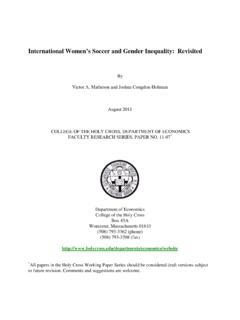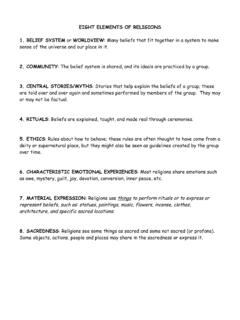Transcription of An Evaluation of the Economic Impact of National Football ...
1 An Evaluation of the Economic Impact of National Football League Mega-events By victor A. Matheson and Robert A. Baade august 2011 . COLLEGE OF THE HOLY CROSS, DEPARTMENT OF ECONOMICS. FACULTY RESEARCH SERIES, PAPER NO. 11-12. Department of Economics College of the Holy Cross Box 45A. Worcester, Massachusetts 01610. (508) 793-3362 (phone). (508) 793-3708 (fax). *. All papers in the Holy Cross Working Paper Series should be considered draft versions subject to future revision. Comments and suggestions are welcome. An Evaluation of the Economic Impact of National Football League Mega-events By victor A.
2 Matheson . College of the Holy Cross and Robert A. Baade . Lake Forest College august 2011 . Abstract This paper evaluates the magnitude and the Economic Impact of NFL mega-events including the Pro Bowl and Super Bowl. The paper also reviews the theory behind the usual findings that the observed Economic benefits of mega-events are almost always a fraction of the benefits claimed a priori. JEL Classification Codes: L83, R53. Keywords: Football , Impact analysis, Super Bowl, sports, mega-event, Pro Bowl This paper updates and extends our previous work on this topic. Portions of this chapter draw heavily from Baade and Matheson (2006), Padding Required: Assessing the Economic Impact of the Super Bowl, European Sport Management Quarterly, Vol.
3 6, No. 4.. victor A. Matheson, Department of Economics, Box 157A, College of the Holy Cross, Worcester, MA 01610-2395, 508-793-2649 (phone), 508-793-3708 (fax), . Robert A. Baade, Department of Economics and Business, Lake Forest College, Lake Forest, IL 60045, 847-735-5136 (phone), 847-735-6193 (fax), Introduction Cities, regions, states, and countries compete vigorously with one another for the right to host mega-events. Political conventions, religious conferences, and sports events such as the Summer and Winter Olympic Games, the World Cup, Commonwealth Games, and the Pan American Games qualify as mega-events.
4 Competition for these events has intensified given the common perception that they have the capacity to transform the Economic landscape in the cities and countries that host them. Heated competition exists within the United States to host mega-sports events for the same reason identified for events with global appeal. Professional sports leagues in the United States have parlayed the promise of hosting their hallmark events into financial gain, and arguably the National Football League (NFL) has done that more efficaciously than any other of the four major sports leagues operating in North America.
5 The NFL s success is attributable to its position as the most popular of the team sports in the United States. Given its stature the NFL s championship and all-star games are particularly appealing to cities who bid for them. The prospect of substantial Economic benefit from NFL hallmark events has given voice to a cadre of civic cheerleaders who extol the virtues of serving as hosts. Hosting, however, comes at a price, and the booster claims have evolved into justifications for the use of public funds or other civic subventions to host the NFL s showpieces. The purpose this chapter is to evaluate the Economic Impact of hosting the NFL s Super Bowl, the all-star game, and the draft of new players.
6 The focus in this chapter is primarily on the Super Bowl, the NFL s quintessential mega-event. The rationale for emphasizing the Super Bowl is that given its stature, the 1. other NFL significant proceedings will induce an Economic Impact less than the Super Bowl. If the Super Bowl does not generate a meaningful increase in Economic activity for the host community, it is less likely that events that are smaller in scope will stimulate the host city s economy. This chapter is organized as follows. Section one provides a context for the Super Bowl and NFL all star games within the panoply of mega-sports events.
7 The second part of this chapter discusses the uniqueness of the NFL as it relates to the costs involved in hosting an NFL hallmark event. The benefits that accrue to the host cities of their hallmark event are analyzed in the third section. The methodology prevalent in before- the-event or ex ante studies used by the boosters to justify public subsidies for mega- events is discussed in the fourth section. Section five critiques the methodological approach used by apologists for public subsidies. An alternative methodology for assessing the Impact of NFL hallmark events is identified and discussed in the sixth section.
8 The estimated Economic impacts of NFL mega-events are detailed and discussed in the chapter s seventh section. Conclusions and policy implications are presented in the final section of the report. How Big is the Super Bowl It is important to provide a context for the NFL s showcase events which include the Super Bowl, the Pro Bowl, and player draft. Cities, after all, could bid for a number of mega-sports events. It is useful to have a sense of where the NFL s events fit into all those put out for bid. The bigger the proceeding, the more likely it will stimulate the host city s economy. This section of the paper focuses on the size of the Super Bowl to provide a basis for understanding the potential Impact of the NFL s mega-events.
9 2. No definition exists for hallmark sports events, but certain characteristics are common to them. As the term suggests a mega-event is defined by scale, which if sufficiently large increases the likelihood that it induces a measurable Economic Impact through increasing tourism and media coverage. Conventional wisdom would identify the World Cup as a mega-sports event, and a context for the potential Economic Impact of the Super Bowl could be provided by comparing the audience and the revenues for the American Football championship to that of the soccer world championship. The information recorded in Table provides some measures, admittedly imperfect, for comparing the two events.
10 Table Select Statistics Comparing the Super Bowl to the World Cup Statistic/Event Super Bowl World Cup Viewership milliona (2010) million (2006 final). and an estimated billion for all 64 games (2006). Number of Games 1 64. Total Time Played 60 minutes 96 hours Ad Revenue $213 million (2009) $1 billion (estimated for 2006). Ticket Price $800-$1,000 (2010) $400-$900 (2010 final). Ad Revenue per minute of $355,000 $176,000. playing time Source: bowl a This represents the largest audience ever to view a television program in the United States displacing the final episode of MASH. The statistics recorded in Table indicate that by the measures indicated, the Super Bowl and the World Cup qualify as mega-sports events on a global scale, even though the Super Bowl viewing audience is primarily based.







